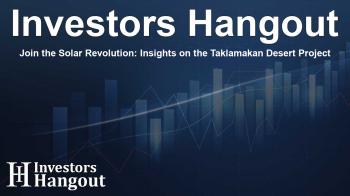Join the Solar Revolution: Insights on the Taklamakan Desert Project

Revolutionizing Energy with Solar Technology
Innovative energy solutions emerge as essential components to mitigate climate change and enhance sustainability. Solar technology, in particular, is gaining recognition for its capacity to convert sunlight into electricity, providing a clean and renewable energy source. One of the most notable advancements in this arena is the initiative surrounding the Taklamakan Desert, a vast shifting desert that has recently drawn international attention.
Encircling the Taklamakan Desert
The Taklamakan Desert, often referred to as the "sea of death," is not just the largest desert in China; it is also the second largest shifting desert in the world, spanning approximately 1,000 kilometers in length. This remarkable project focuses on creating a protective green belt around the desert, stretching 3,050 kilometers. The green belt comprises vegetation and advanced sand-blocking technologies powered by solar energy, a promising model for sustainable development.
The Impact of Green Technology
What makes this project stand out is not just its scale, but its intention to address environmental challenges. By strategically employing solar-powered systems to manage desertification, the initiative has the potential to transform vast deserts into sustainable landscapes. This endeavor not only protects surrounding agricultural lands from being overtaken by sand but also enhances air quality and biodiversity in the region.
Benefits of the Solar Wall
The solar wall serves several critical functions that benefit the local ecosystem and community. Primarily, it reduces the risk of sandstorms and soil erosion, which can devastate crops and disrupt local economies. With better air quality, communities near the desert can experience improved health outcomes.
Economic Opportunities and Future Growth
Aside from environmental benefits, the Taklamakan Desert project is anticipated to create numerous economic opportunities. By leveraging solar technology, the initiative will create jobs in construction, maintenance, and operations. This could spur additional investments in green technologies across the region, paving the way for a more sustainable future.
Global Implications of Desert Encirclement
The implications of this project extend beyond China's borders. As climate change becomes a pressing global issue, the approaches developed in the Taklamakan Desert can serve as a blueprint for other countries facing similar challenges. Each successful implementation of this kind can inspire nations to adopt sustainable practices that contribute to battling desertification worldwide.
Collaborative Efforts and International Support
This ambitious project necessitates collaboration among various stakeholders, including government agencies, environmental organizations, and the private sector. By working together, these entities can pool resources, expertise, and technologies necessary to actualize the project’s goals.
Engaging the Community
Moreover, engaging local communities is crucial for the project's success. Education and outreach programs can help local residents understand the advantages of sustainable practices, cultivating stewardship of their environment. Through these efforts, communities will not only benefit from improved surroundings but will also take pride in being part of an innovative solution.
Conclusion: A Step Towards a Sustainable Future
In conclusion, the Taklamakan Desert Encirclement Project represents a groundbreaking approach to addressing environmental challenges while paving the way toward a sustainable future. As we witness the revitalization of this vast desert through innovative solar technology, we are reminded of the potential that lies ahead when communities collaborate to harness renewable energy.
Frequently Asked Questions
What is the purpose of the Taklamakan Desert project?
The project aims to encircle the Taklamakan Desert with a green belt to combat desertification and utilize solar-powered sand-blocking technologies.
How does solar technology contribute to this initiative?
Solar technology powers the mechanisms that help manage sand movement and sustain vegetation, ultimately transforming the desert environment.
What are the potential economic benefits?
The project is expected to create jobs in construction and maintenance, stimulating local economies and inviting investments in green technologies.
Why is community involvement important?
Engaging local communities fosters ownership of the project, ensures educational outreach, and promotes sustainable practices that benefit both the environment and the people.
What lessons can be applied globally from this project?
This project serves as a potential model for other nations facing desertification and environmental challenges, offering strategies for sustainable management and collaboration.
About Investors Hangout
Investors Hangout is a leading online stock forum for financial discussion and learning, offering a wide range of free tools and resources. It draws in traders of all levels, who exchange market knowledge, investigate trading tactics, and keep an eye on industry developments in real time. Featuring financial articles, stock message boards, quotes, charts, company profiles, and live news updates. Through cooperative learning and a wealth of informational resources, it helps users from novices creating their first portfolios to experts honing their techniques. Join Investors Hangout today: https://investorshangout.com/
Disclaimer: The content of this article is solely for general informational purposes only; it does not represent legal, financial, or investment advice. Investors Hangout does not offer financial advice; the author is not a licensed financial advisor. Consult a qualified advisor before making any financial or investment decisions based on this article. The author's interpretation of publicly available data shapes the opinions presented here; as a result, they should not be taken as advice to purchase, sell, or hold any securities mentioned or any other investments. The author does not guarantee the accuracy, completeness, or timeliness of any material, providing it "as is." Information and market conditions may change; past performance is not indicative of future outcomes. If any of the material offered here is inaccurate, please contact us for corrections.
